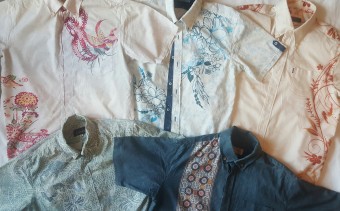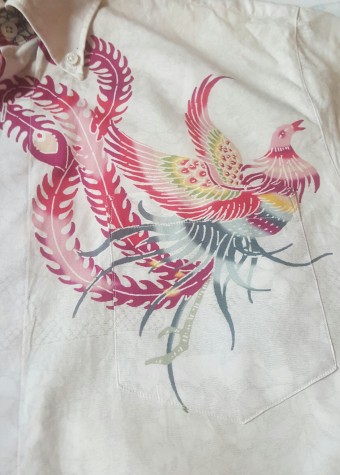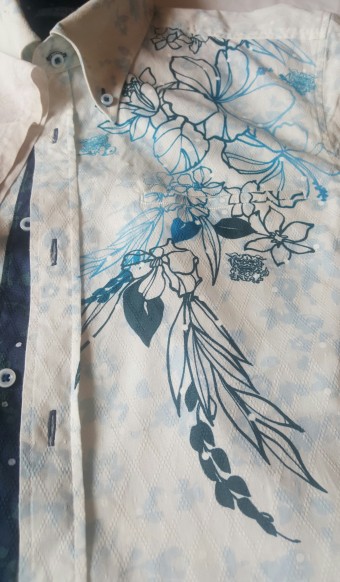
I enter a room full of young Okinawans, who have come to Australia to teach Eisā, a traditional form of music and dance. Too proud to actually learn myself, I only duck in with my mother to say hello. I see the Okinawans, my age or slightly older, lower their gaze as I walk in. The source of their embarrassment registers in my unconscious, but I don’t allow myself to acknowledge it at the time. It’s my ridiculously ostentatious Kariyushi shirt.

I smile on in that buffoonish way that I do, scanning the room. I can see only one other person wearing a Kariyushi shirt: the elderly Tamaki-san or Tanuki-san as we call him – Mr Raccoon – with whom I got robustly drunk one night, enjoying his unending stream of puns. The exchanges that ensued were hurried by the, to me, still intangible cushion of shame that had ballooned with my presence. Nonetheless, as we leave, my mother drops me a hitherto unknown morsel of shattering information: ‘Yeah…it’s only really old men that wear Kariyushi shirts.’ As we leave for lunch, I feel a cataclysm of unrecognisable ridicule erupting in the distant intensity of that tiny room. I continue smiling with a sort of naïve optimism, but my furrowed brow suggests niggling feelings of confusion.
Cut to me at a conference featuring race and whiteness in Australia; I talk on Oriental depictions of Japanese in Australia, Aboriginal sovereignty, Okinawan indigeneity, cultural appropriation etc. I get a rousing applause. My Kariyushi shirt loudly expresses pride, resistance, ethnic identity. Its defiant boldness symbolises my own reaction against the cumulative effect of a youth filled with whitewashing and internalised racial inferiority.
How to reconcile these divergent feelings toward the Kariyushi shirts that I’m now addicted to collecting? What does it mean to wear a Kariyushi shirt in Australia?
The Kariyushi shirt is a sort of Hawaiian shirt worn in Okinawa, an archipelago located in Japan’s south. Okinawa used to be a separate kingdom – the Ryukyu Kingdom. It had a tributary relationship with China’s Ming and Qing dynasties, and it traded with various East Asian and South East Asian cultures. In 1609 the Satsuma domain of mainland Japan invaded Okinawa, and some see this as the beginning of a colonisation process that led to Okinawa becoming a prefecture of modern Japan. After the post-WWII US occupation, Okinawa was a US colony until 1972. Okinawans continue to debate and protest the lingering presence of US military bases that are set up on large expanses of Okinawan land.
But I didn’t grow up in Okinawa, I grew up in Australia. For family reasons, my mother didn’t go back; not until much later when my sister and I were adults. I identified as Japanese and knew almost nothing about Okinawa itself. In a sort of double-assimilation a larger Japanese identity subsumed my Okinawanness, and white Australia subsumed that. So, for me, wearing Kariyushi represents part of an ongoing process of attempting to acquaint myself and ‘re’-connect with Okinawa.
However, I want to highlight an important point: I feel fundamentally disconnected from the culture of Okinawa, as it is in the place of Okinawa. The culture isn’t a part of me in any substantial way that I can grasp or hold on to. While I’ve researched about Okinawa, I’m part of the Okinawan Australian community (what there is of one), I’ve visited Okinawa twice – culturally, I feel totally alien to it. No indigenous Okinawan essence courses through me when I wear Kariyushi. And yet, I feel totally compelled to wear these shirts.
Is this an appropriation? An empty flaunting of someone else’s culture? No, I don’t think that either. This article doesn’t centre on cultural appropriation, I should note. It explores diasporic experience, which is very different. My basic position here is that an Okinawan Australian wearing a Kariyushi shirt does not constitute cultural appropriation. This issue contains many nuances, but I’m not having this discussion here. In addition, Kariyushi shirts themselves do not commodify an indigenous culture in any clear-cut way.
Kariyushi shirts were originally produced in Okinawa to promote tourism in the 1970s – those were worn by hotel staff and tour guides. While some used traditional Okinawan prints like Biingata, others were modelled after Hawaiian Aloha shirts. The first Hawaiian shirts, incidentally, are attributed to a Japanese kimono maker living in Hawaii in the early 1900s. They were then popularised by a Chinese merchant in the 1930s.
Certainly, however, the cultural resonance of Kariyushi wear differs in Okinawa compared to in Australia. In Okinawa it’s formal wear or work wear. In Australia, I wear it whenever I want. There exists no cultural resonance here; people think it’s a Hawaiian shirt. Maybe if the shirt displays a particularly Asian pattern or symbol like a phoenix or Shiisā (lions) people might think it’s Chinese. I think Asian Australians read it differently to white Australians too. Sometimes I think I perform my Asianness in Australia by wearing Kariyushi – to Chinese Australians there must be something oddly anachronistic about the traditional Chinese symbols on some of my Kariyushi shirts.

But despite, or perhaps because of, this weird mis-interpellation created by my shirts, I relish wearing them. I love the unstable signifier that they represent; how they suggest no clear East-West binary – they represent a confused mishmash of Okinawan, Ryukyuan, Australian, Japanese, Chinese and Hawaiian culture. Perhaps they resonate with Pacific Island and South-East Asian cultures as well.
To me these shirts embody the essence of diasporic experience, second-generation migrant experience, mixed race experience, Asian Australian experience. When I go out wearing these shirts, I don’t preserve some original Okinawan identity. I’m shaping it up. Okinawan Australian identity, for me, is something created and changed every day. And not even by me; it’s created through interaction with the cultural mixture that is Australia. When I wear the shirt, I become Okinawan Australian, again and again in different ways. That identity means whatever I want it to mean on that day – plus however that relates to what others want it to mean (including Okinawans).
And this highlights the unique thing about Uchinanchū, the Okinawan word for Okinawan identity. On my first visit to Okinawa in 2009, I attended a massive festival and parade in which diasporic Okinawans from all over the world returned to the homeland to celebrate transnational Okinawan identity. ‘Uchinanchū spirit’ is not racially or nationally exclusive; it is extraordinarily inclusive. It includes all people of Okinawan descent and even just people who identify with Okinawa. This festival made clear how Okinawan people disseminated their culture all around the world and in the process mixed with many different customs.
Rather than emphasising some native essence or authenticity, as we sometimes inadvertently do in studies of culture and race, I’ve tried to highlight, here, the unique mixed position of diasporic experience. We need to value the cultural mixture created by this experience and not see it as some bastardisation of an original culture. The potential of intercultural or cross-cultural identification is pretty essential to any notion of multiculturalism we might want to entertain.
So I am going to keep wearing these shirts, I like to imagine, for the rest of my life. I want to know how they mean differently over time, how they carve a multifaceted Okinawan identity through immersion in different times and places. And I’m going to enjoy their unapologetic extravagance too.

